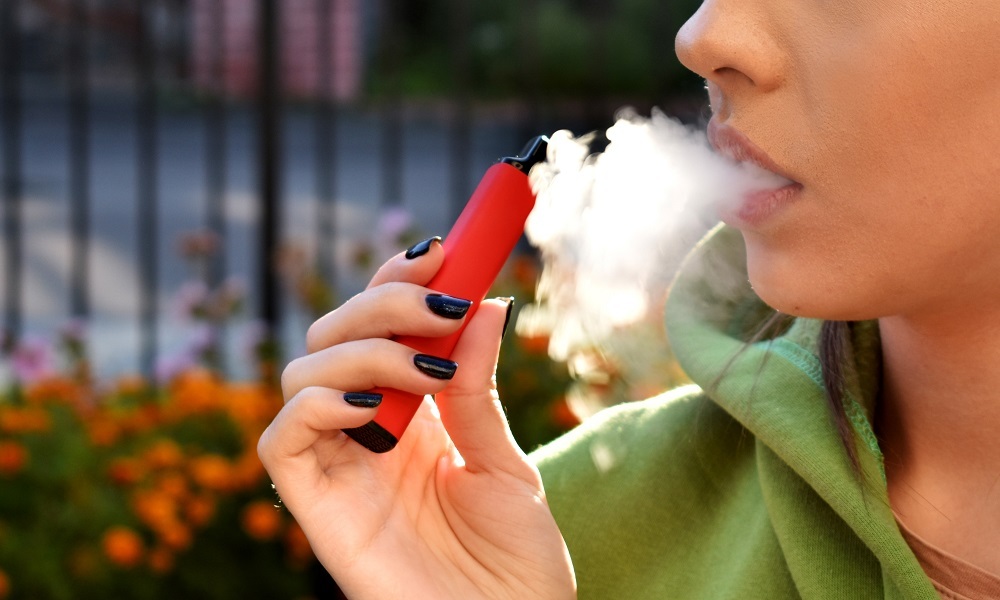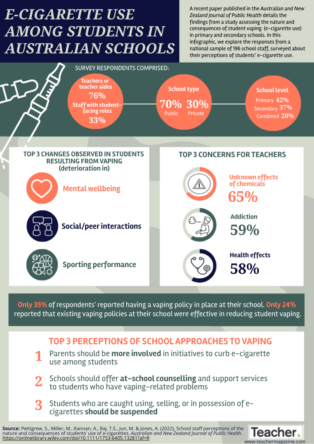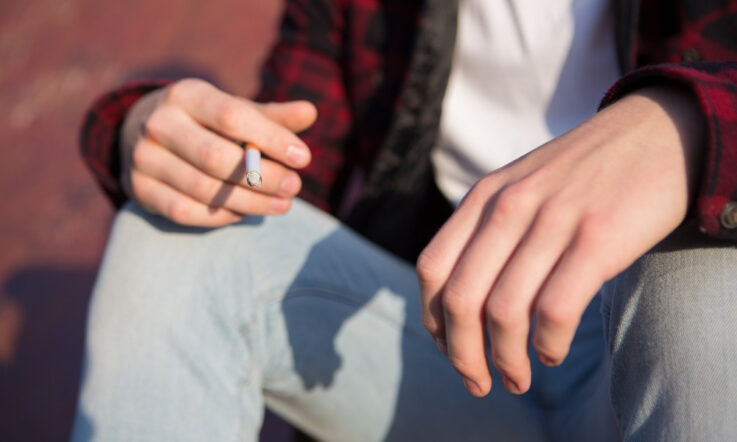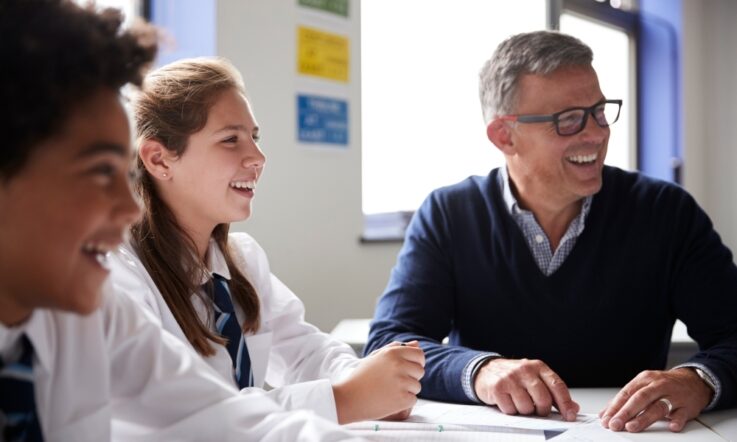Thanks for downloading this podcast from Teacher magazine. I’m Dominique Russell.
We know that e-cigarette use among adolescents in Australia has quickly become a pressing issue for schools. In fact, data released last year showed that teachers are specifically worried about vaping addiction and the unknown effects of chemicals in e-cigarettes.
But what do students themselves think about vaping, and what kind of support would they value and respond to? How can educators empower them to say no to vaping, and work towards the prevention of e-cigarette use among young people? In this episode of The Research Files we’re going to hear from the PERU team (which stands for Prevention Education and Research Unit). They sit within the Western Sydney Local Health District’s Research Education Network and have been looking into the issue of vaping through their ongoing research project, the Unpacking Vaping in Schools Project.
Joining me today is Professor Smita Shah OAM, the Director of PERU; Kym Rizzo Liu, the Project Manager of PERU; and Catriona Lockett, Research Officer at PERU. Let’s jump straight in.
Dominique Russell: Thank you to the 3 of you for joining us on this episode of The Research Files. I thought to kick us off it would be great to get a quick introduction to each of you and your roles for our listeners. Smita, would you like to start us off?
Professor Smita Shah OAM: Thank you, Dominique. I'm a Professor of Public Health at the University of Sydney and the Director of Prevention, Education and Research Unit, commonly known as PERU.
Kym Rizzo Liu: Hi, I'm Kym. I'm the Project Manager of PERU. And, actually in my past life, before starting here in 2019 I did work as a PDHPE teacher in NSW Public Schools for quite a while. I won't disclose the years, however!
Catriona Lockett: Hi. I'm Catriona. I'm the Research Officer for PERU and in a not-so-distant past life, I just completed my Master of Public Health at Sydney Uni. And now I'm looking to start my PhD in evaluating the effect of school-based e-cigarette prevention programs.
Dominique Russell: And we heard just there, you're all part of the PERU team. Smita, can you give us a bit of an introduction to PERU?
SS: Yes, we are known for delivering innovative community and school-based prevention and leadership programs which help to make a difference to lives of young people. And we've been doing this for over 25 years in our schools.
So a little bit more about PERU – we sit under Research and Education Network within Western Sydney Local Health District. We work in partnership with schools and with a range of services, including general practice associations in the local area.
What's important is that our work in schools complements their efforts to promote health and wellbeing and agency amongst young people. For instance, take our award-winning peer-led SALSA program, which stands for Students As LifeStyle Activists. The SALSA program has empowered over 25,000 students across in Australia to eat more fruit and vegetables and be more physically active whilst building communication as well as teamwork and leadership skills.
Just to give an idea about how the GPs work, the GP associations support the school action plans, for example, to create supportive school environments. And recently they just funded the installation of water refill stations in 6 of our schools.
And currently we are partnering with Health Wise and the Department of Rural Health, University of Newcastle, to trial the SALSA program in regional schools in NSW. Another program, another significant impact that we've made in schools has been with our Triple A program (Adolescent, Asthma Action). It has shown to improve asthma outcomes as well as a reduction of smoking among students in Australia, as well as the Indigenous communities, but also overseas in schools in Jordan.
So our models of work has been directly responsive to the needs of the school community and in the past few years we took on the public health issues affecting our young people such as COVID-19. Recently, in response to the needs of the schools, we have now extended our work to prevent and stop e-cigarette use in adolescence at the grassroot level. And our approach with schools is centred around collaboration and evidence-based interventions.
DR: And today, we're going to be discussing your Unpacking Vaping in Schools Project, which has been ongoing since 2021. Kym, how and why did this project get started?
KRL: So our journey actually with e-cigarettes started in early 2021 when the principals from Western Sydney High Schools raised their concerns about the increasing prevalence of student vaping. We were really determined to address this emerging issue, so we launched a community-wide project with the goal of empowering young people to prevent e-cigarette use.
So to start our efforts off, we did, like most people would do, we conducted a scoping review so that we could understand actually what existed out there in terms of adolescent e-cigarette use in Australia. We recognised, however, that there was a need for deeper insights and strategies that would resonate with the school community, so we conducted our first workshop as a pilot at Erskine Park High School, where we talked to students in one session and then we had another session. We talked to school staff and then we held another session where we talked to parents and guardians.
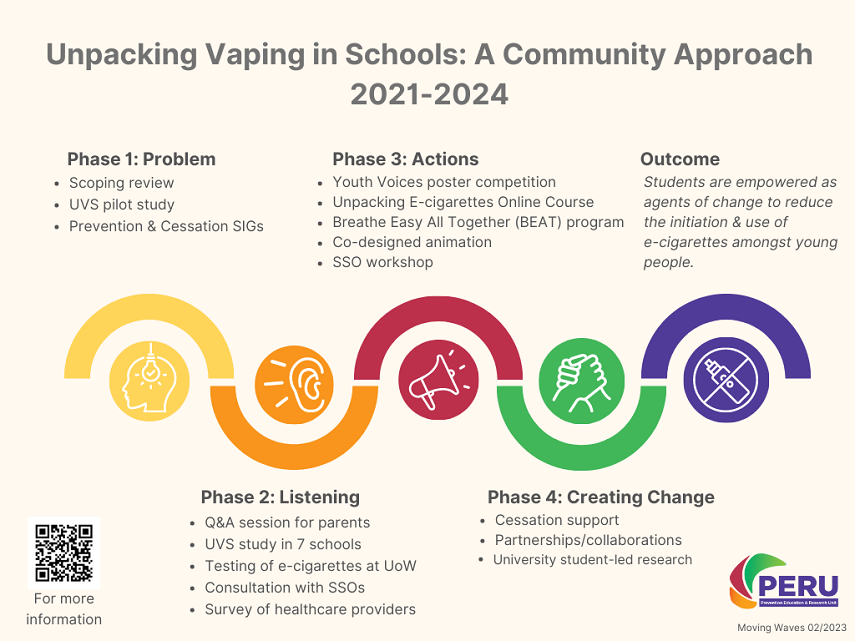
The phases of the Unpacking Vaping in Schools Project. Image: supplied.
DR: And you call the project a ‘community approach’. Catriona, what's meant by that? And why is that important?
CL: So for us, the term community approach means that we involve all members of the school community who have a role to play in the prevention of e-cigarette use amongst young people at the local level. And it's about emphasising the voice and agency of a range of community members like parents, students, staff, health and educational professionals, to collectively address the issue of adolescent vaping.
So as part of this approach, we've taken kind of several steps to kick it off. We first started by organising a dedicated Q&A session on Zoom to address parents’ concerns and gather their perspectives. This really ensured that their voices were heard and valued as part of this process and following this we established monthly e-cigarette prevention and cessation special interest group meetings (it's a mouthful). So they're comprised of professionals from various fields, including health, education, students, staff, parents and consumer reps. And these meetings serve as a platform to really share information, develop strategies, and build partnerships to effectively take on this issue of vaping in our students.
We've also collaborated with the University of Wollongong to conduct chemical analysis of the e-cigarettes that were confiscated from high school students to provide valuable insights into the products that were actually being used by the students themselves.
So building on the success of our pilot study, that Kym mentioned earlier, we expanded the Unpacking Vaping in School study to 7 high schools in Greater Western Sydney. This allowed us to understand the perceptions of students, staff and parents regarding adolescent e-cigarette use and to unpack their preferred prevention strategies.
KRL: Yeah, so just adding to what Cat’s saying about why it's really important to involve the school community, we actually find that if you actively involve the people that are part of the school community, or part of a community in general, that they feel a sense of ownership and empowerment. This was really evident through the ongoing commitment of the schools to take on our action-based research and not only that, but the schools’ initiatives to actually take action themselves.
So for example, at the consultation session for parents and guardians at one of the study schools, it was mentioned that there was a shop that was selling vapes to minors and this was raised by the people at that meeting. And then after that particular consultation session, the actual school community worked together and they successfully took down a local retailer.
SS: I'd like to just add to that, that the evidence shows that by providing a platform for the school community to share their input and involving all stakeholders in the decision process, we can develop more effective, relevant and sustainable prevention strategies. And that's what we are about. We are working in the area of prevention and we want to make sure that whatever we start up actually is retained at the at the school level. And so that's why the emphasis is on the partnership with the schools. We don't sort of dictate to them. We work with them. And when we ask students how they felt about being involved in the study, what was interesting is the feedback universally was that they felt that their choices mattered. They felt heard. And that is what we what we wanted. Even our teachers also felt the same way. And parents also felt that at least they were listened to before we went in to do something.
DR: And so we've mentioned a bit earlier there that this project kind of kicked off with a large scoping review. I'm interested then if there is any more detail you can share about how much research was out there already about the use of e-cigarettes by adolescents in Australia?
CL: Yeah, well, prior to our study, there was limited published literature on e-cigarette use amongst adolescents, at least in the Australian context. There were existing studies from countries like the UK, Canada and the US, which indicated that young people viewed e-cigarettes as a safer alternative to traditional smoking.
They also found that e-cigarettes were attractive due to their appealing flavours, and they were influenced by their peers and even family members to also take up vaping. However, there was a general understanding that vaping did carry some risks and that the information out there on the contents and the health-related harms of vaping was generally inconsistent.
DR: And it's very clear already that you've done so much work in this project already. Can you share with me what the aims were of this entire project?
CL: So building on that kind of gap in the literature, the aims of the Unpacking Vaping in Schools Study were to, first, explore the knowledge, attitudes and perceptions of e-cigarette use among student staff and parents. And secondly, to determine what information is important to students and how to effectively communicate these e-cigarette prevention messages to young people. Our focus was to initiate conversations about vaping and understand what the school community would like to really see to address e-cigarette use at the grassroot level.
DR: And so then in a nutshell, how was the study conducted?
CL: We conducted the study with 7 high schools in Greater Western Sydney, as I mentioned earlier. And through this study, we listened to 162 students, 133 school staff and 29 parents. To do this, we obtained ethics and SERAP (State Education Research Application Process) approval for students to have opt out consent, which ensured that we had inclusivity within our study and that we could hear all voices authentically.
And to listen to the school community and what they had to say about vaping, we held face-to-face workshops with students and staff and then we had Zoom sessions with parents for ease of access. During these sessions we use interactive strength-based activities which included post-it note polls, small group brainstorming and open group discussions.
SS: And how our study actually differed from others is that instead of a survey we actually worked with our students, and we heard our students in a very interactive way. And I think that is really important and that's what Kym and myself, we've sort of went to all the schools and there was an amazing involvement. There was not one area where students actually said to us ‘Oh, we don't want to be involved’, or teachers pulled out or something. Everyone was really keen to be involved.
KRL: And I think what's also really important is that when the students did break up into the small groups, they did have a facilitator – so either myself or Smita or whoever was with us – sit with those groups, but we didn't give any of the kids answers, so the students gave the answers themselves.
So that's really important that they had that space and that we were just there basically to listen to them and to guide the process, not actually the answering or guide their answers to a particular way that we wanted them to present an idea.
SS: Yeah. And this is quite unique, Dominique, when you're doing research at schools, because this is not how they normally use surveys. And most, and that's why we feel our study is quite unique.
DR: And Catriona, just to pick you up on something that you mentioned just before and I wonder if it would be quite new to our listeners. You mentioned you were attained ethics and SERAP approval. Can you describe what SERAP approval is?
KRL: So it's getting ethics for NSW public schools to be able to go in and conduct the research in the public school system in NSW. The ethics that we get from the university covers the 3 sectors, but then within each sector they obviously have their own processes they want you to follow. And SERAP just happens to be the public school process.
DR: So, Catriona, can you tell me about a bit about your findings so far and where you're at right now?
CL: Yeah, in our study we found some common findings amongst the 3 groups regarding e-cigarettes. There was a shared recognition that vaping was viewed as pervasive and harmful to young people, but there is also a strong desire for more reliable information out there and the implementation of stronger policy, which is unsurprising.
However, we also observed some differences in the specific information that each group would like to receive around vaping. So students expressed a curiosity about the mechanics and addictive nature of e-cigarettes. So thinking about how do they work and why are they so addictive?
Staff want more practical information about managing the problem of vaping in schools, such as having access to effective educational and punitive strategies. And parents, on the other hand, they wanted to know virtually everything there is about vaping on top of how they can meaningfully engage their children in factual conversations about the issue.
And when looking at the reasons why young people vape, we found that adolescent e-cigarette use was attributed to the interplay of several complex factors. And these factors included the social normalisation of vaping and peer pressure, the perception that it's not like smoking and the use of e-cigarettes as a coping mechanism for mental health issues in young people.
It's worth noting that there are differences in how staff and parents and students perceive and experience vaping. Staff and parents tended to view e-cigarettes as a safer alternative, whereas students focused more on the social normalisation of vaping, experiences of low confidence to refuse e-cigarettes from their peers, and something that really stood out, for us at least, was the use of e-cigarettes to cope with mental health issues.
And when it comes to concerns and what each group was concerned about vaping, again we found important differences there. So students were concerned about the misuse, addictiveness and gateway effective e-cigarettes, and that it might lead to the uptake of more risk-taking behaviours. Staff are concerned about the education, learning and behaviour of students and parents are concerned about their ability to have open and honest conversations with their children about vaping. So as we can kind of see throughout the data, everyone's concerns and the information that they'd like to receive is really reflective of their role in the students’ lives.
And to sum it all up, I'll pull out 4 key messages which really stood out for us. So first and foremost, understanding the different perspectives and experiences of each group is crucial in developing targeted prevention strategies. As I'm sure schools already know, a one size fits all approach does not work.
Secondly, how we engage with young people is just as important as the content and the messages we deliver to them. Peer-led initiatives and co-designed prevention messaging, which empower students, were actually the preferred methods of communicating and working with young people as compared to just simply being told what to do.
Thirdly, a comprehensive approach involving the whole school and community is necessary to effectively support the prevention and cessation of e-cigarette use and students. And lastly, but not least, we need strong partnerships between health and education, particularly including schools in the decision-making processes and implementation to effectively deliver these strategies.
SS: What Catriona has just presented is just a little bit of the data that we collected. There is a lot more data which we are about to publish as well, but we felt that these were the areas that the schools would be particularly interested in hearing.
… What was also interesting is that we actually shared this data with the schools prior to any presentation and was very well-received by the principals from each of the schools. And each school actually received a very detailed report of all the data that we collected, including a one-page infographic summarising the results. And this is part of how we work with schools, so that when we actually collect any data from schools, we share that with the schools.
CL: Yeah, it's all about ensuring transparency and ownership of data. I think that's something that comes through really strongly with our methods.
DR: And so your works not done with this project. Kym, can you share what's still to come?
KRL: Yes. So looking ahead out, unpacking vaping in schools project has some really exciting initiatives in the pipeline. So this includes – well, the first one, we've actually already done, so it's not in the pipeline, but that was our first student initiative that was launched on World No Tobacco Day in 2022 and we did that in partnership with Population Health. It was called the Youth Voices Unpacking Vaping Poster Competition. It was for Western Sydney High School students.
We had over 80 students from 17 schools submit 69 posters in which they could address either the health effects, the tobacco marketing tricks or the environmental harms of e-cigarettes. The post survey results actually showed that 92% of students agreed or strongly agreed that they had a better understanding of the harms after participating in the competition. And I mean that would be no surprise to any school staff or any teacher in that if we involve them, they're more likely to actually take on those messages.
The other thing that we have is the Unpacking E-cigarettes Online Course. We recently actually launched that this year on World No Tobacco Day, so it's a bit of a theme going on there. And that is a self-paced online course and it's designed to complement PDHPE curriculum. So it has been actually linked to the NSW stage 4 PDHPE curriculum, but I'll be working on linking it to the HPE curriculum in Victoria and Queensland, Western Australia and so on. So this course actually covers e-cigarette content, the harmful effects, the alternatives, which is really important to provide alternatives of use, and then also gives those students an opportunity to practice their refusal skills.
In 2022, we piloted it with over 250 students across 6 schools and all of those 6 schools were involved in one way or another – part of our study, or the pilot school. And their feedback highlighted some really key things, in that it's user friendly, so that's a good thing, that is interactive in nature, really positive. I love that it gives you positives when you get your answers correct, like ‘cool beans’ and ‘you're on fire’ and it has these really funny built-in GIFs and stuff (well, I think they're funny) and also the importance of raising awareness among junior students came through strongly as well.
We have other things also planned, so it's called BEAT and BEAT is Breathe Easy All Together program and it's designed to empower high school students to develop leadership, resilience and refusal skills whilst learning to manage asthma and prevent e-cigarette use. Students have the opportunity to then build on some work ready skills. So, we know that's really important that students have these opportunities to develop these skills and they do that through coming up with their own social marketing project, like creating a social media campaign. Again, that's open ended. It will be up to the students what they want to do to convey prevention messages within their school community.
As part of this program, we also co-design an animated video with students – so as you can see here, it’s a bit of theme, we like to involve students in our work – to use as an empowerment tool for the program to ensure that the video resonates with its intended audience, the kids. We thought if we did it, we could probably make a really good product, but it may not actually sit well with the kids. So we find that the process of co-designing with students to be really important in our work.
SS: What I'd like to add on – a couple of areas. First, in the poster competition, those posters are available on our website and they're available to schools across Australia. We've actually distributed them to any schools that would… and they're available electronically and they and then some schools, we can send them the physical copies as well.
The online course has been now, literally we've had schools from across from Western Australia, Victoria and Queensland requesting for it. We're basically looking at how to get how to get some funding to be able to build on the capacity of our team to be able to share that. So it's out there, ready for use. We're just working in working with health to see how we can actually share this wider.
With the BEAT program, what is really important is, the reason why we added asthma is the work that we've done with schools is that if you just address tobacco by itself or e-cigarettes on its own, it often puts off young people. So as Kym has mentioned, we really like to work with strength-based approach. So one of the areas we know that asthma is a very common problem in our schools and it's something that young people can relate to.
So we sort of use that as a vehicle of getting into the schools rather than just saying ‘Oh, we've got a program on e-cigarettes’, because it often puts people off, they think ‘I don't want to be part of this’. We wanted them to feel that this is something about where they can be involved in creating an environment where all students can breathe easy and the BEAT part is – actually we want to use some innovative music and things like that, you know, but we haven't yet done it yet. We're still in the process of working. So anyone interested in doing some beats for us would be welcome, just contact us. It would be fabulous to have other schools involved as well. We are very passionate about this work and it's something that Catriona is going to be doing as part of her PhD in evaluating the process and making sure that it actually resonates well with the students.
CL: And enough about prevention. But Smita, what else is happening in cessation?
SS: Well, this is one of the things that we found was really when was really sad. When we listen to the students, many of the students were telling us, ‘Stop talking to us about e-cigarettes, help us’. They will literally, practically – and you could see that many of these students already had problems with nicotine addiction and they were already vaping.
And whilst we weren't identifying students who were actually vaping, we found that when we were talking to the schools, there's very little services out there for students that were actually vaping. So this is why we started looking at how can we support students in e-cigarettes cessation? And to achieve this, we are a small team, we therefore partnered with my clinical colleagues and academics to study first of all the knowledge, attitudes and practices of healthcare providers, including GPs, paediatricians and pharmacists. We wanted to know their thoughts on adolescent e-cigarette use before we came up with any interventions.
And at the school level we also listened to student support officers, which are called SSOs in NSW, and we want to be able to work with students, support officers, school nurses and community liaison offices to equip them with effective strategies for e-cigarette prevention and cessation. And again, we are partnering with other organisations who are already working in this area and we don't want to reinvent the wheel, but we want to be able to work together and test out how relevant it is, because at present there's no evidence to show what's the best way to prevent e-cigarette cessation in young people.
Our approach overall will combine research, training and clear referral pathways to provide a comprehensive support that addresses both the physical and psychological aspects of nicotine addiction, which Catriona highlighted in her data in young people.
Dominique Russell: So before we wrap up for the episode, is there anything else that you'd like to mention?
SS: We'd like to highlight the importance of a comprehensive whole school approach, which the evidence has been has highlighted as well. Our work has done that as well as the Matilda Centre has also shown that the whole school approach is the way to go to address e-cigarette use among students. Our work complements the NSW Health Do you know what you're vaping? Campaign.
KRL: … And also our work really does complement the NSW Department of Education’s Resources that they developed for stage 4 and stage 5 PDHPE.
… So I'm really looking forward to actually trialling and testing the BEAT program this term amongst our other work that we do as well and excited to tackle this issue with schools as I think, if we continue with this community approach that it's the way in which we're really going to see numbers start to decrease and we'll start to see young people getting on top of this. As in, not to be corny, but as in beating the issue.
CL: And I think to wrap it all up, we would like to acknowledge that unfailing support of our organisations, the Research and Education Network at Western Sydney Local Health District, our partner schools, members of the unpacking vaping special interest groups and the Western Sydney Primary Health Network for their funding support because without any of them, we can't make it happen.
If you're interested in any of the programs we've spoken about today, check out our website, which Dominique will link in the podcast notes. On the website you can find a contact form that you can fill out and we'll get back to you.
SS: … We have a dream in getting our young people using social marketing strategies and taking on the tobacco company to ‘ghost’, as they say, to ‘ghost’ e-cigarettes from their schools.
That’s all for this episode. Thanks for listening. There were lots of things mentioned in this episode, but don’t worry, we’ll include a list of related links at the bottom of the transcript of this podcast episode, which you can find at our website, teachermagazine.com. Just click on the audio tab at the top of our homepage and scroll down until you see The Research Files Episode 84. We’ll be back with a new episode very soon.
Related links:
The Unpacking Vaping in Schools Project has found that adolescent e-cigarette use can be attributed to the normalisation of vaping, peer pressure, and the use of e-cigarettes as a coping mechanism for mental health issues. As a school leader, how could you use this knowledge of why students take up the use of e-cigarettes to inform the supports you could put in place?
The Project also found that peer-led initiatives and co-designed prevention messaging are the preferred methods of communication on the topic of vaping with young people. Reflect on the prevention and education methods currently in place in your school setting on vaping. Are they peer-led? Do these methods empower students? How could you better involve students as co-designers in the future?
